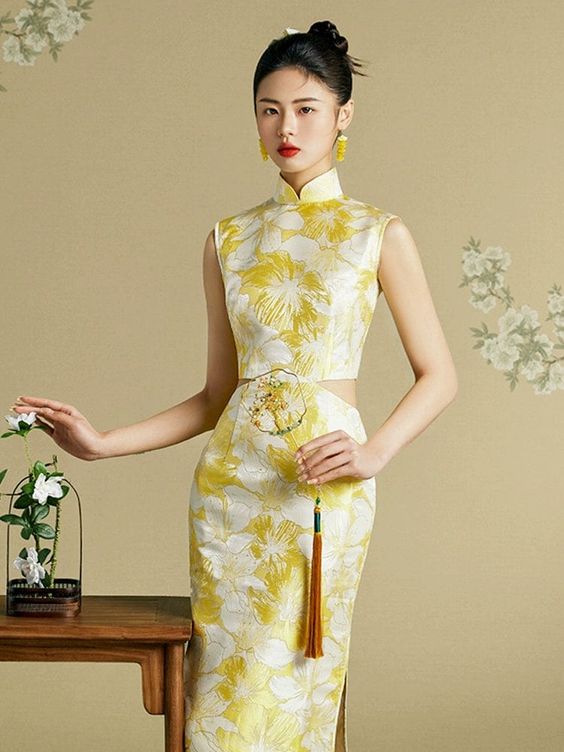The Peony: Symbol of Wealth and Prosperity
IL qipao, a traditional Chinese vestito, is renowned for its exquisite embroidery and intricate patterns. Among these patterns, the peony holds a prominent place, symbolizing wealth and prosperity.

Cultural Reverence for the Peony
The peony, with its lush petals and vibrant colors, has long been revered in Chinese culture. It is associated with the arrival of spring, renewal, and good fortune. In the context of the qipao, the peony pattern embodies these auspicious qualities, bestowing upon the wearer the blessings of abundance and prosperity.
Monetary Significance
The peony’s association with wealth stems from its resemblance to the shape of ancient Chinese coins. The round, full petals of the flower evoke the image of coins, symbolizing financial success and material well-being. Moreover, the peony’s vibrant colors, particularly red and gold, are traditionally associated with prosperity and good luck.
Social Status and Honor
In addition to its monetary significance, the peony also represents social status and honor. During the Qing dynasty, the peony pattern was reserved for high-ranking officials and members of the imperial court. Wearing a qipao adorned with peonies signified one’s elevated position and respect within society.
Complementary Symbols
The peony pattern on the qipao is often complemented by other auspicious symbols, such as the phoenix, dragon, or auspicious clouds. These motifs further enhance the garment’s symbolism, creating a harmonious ensemble that conveys wishes for wealth, prosperity, and good fortune.
Personal Aspirations
The peony pattern on the qipao is not merely a decorative element; it is a powerful symbol that embodies the wearer’s aspirations and beliefs. By incorporating this auspicious motif into their attire, individuals express their desire for financial success, social status, and a life filled with abundance and prosperity.
The Lotus: Symbol of Purity and Enlightenment
The qipao, a traditional Chinese dress, is renowned for its intricate and symbolic patterns. Among these, the lotus flower holds a particularly significant place, embodying purity and enlightenment.

Sacred Symbolism
In Chinese culture, the lotus is revered as a sacred flower, emerging from murky waters to bloom with pristine beauty. This symbolism extends to the qipao, where the lotus pattern represents the wearer’s aspiration for spiritual growth and transcendence.
The Eightfold Path
The lotus’s eight petals symbolize the Eightfold Path of Buddhism, a path leading to enlightenment. Each petal represents a virtue: right understanding, right thought, right speech, right action, right livelihood, right effort, right mindfulness, and right concentration. By adorning a qipao with a lotus pattern, the wearer expresses their commitment to following this path.
Resilience and Inner Strength
Furthermore, the lotus’s association with purity extends to the wearer. The flower’s ability to thrive in muddy waters symbolizes the individual’s resilience and ability to overcome adversity. The qipao, adorned with the lotus pattern, becomes a symbol of the wearer’s inner strength and determination to remain unblemished by life’s challenges.
Longevity and Prosperity
The lotus pattern on the qipao also represents longevity and prosperity. In Chinese mythology, the lotus is believed to be the flower of the immortals, granting eternal life to those who consume it. By incorporating the lotus pattern into their attire, the wearer expresses their desire for a long and prosperous life.
Attrazione estetica
In addition to its spiritual and symbolic significance, the lotus pattern on the qipao adds an element of beauty and elegance. The flower’s delicate petals and vibrant colors create a visually stunning effect, enhancing the overall aesthetic appeal of the dress.
Conclusione
In conclusion, the lotus flower pattern on the qipao is a powerful symbol of purity, enlightenment, longevity, and prosperity. It represents the wearer’s aspirations for spiritual growth, resilience, and a long and fulfilling life. As a timeless and meaningful motif, the lotus pattern continues to adorn qipaos, embodying the rich cultural heritage and symbolism of Chinese tradition.
The Chrysanthemum: Symbol of Longevity and Joy
The qipao, a traditional Chinese dress, is renowned for its intricate and symbolic patterns. Among these, the chrysanthemum holds a prominent place, embodying the virtues of longevity and joy.

The Flower of Longevity
In Chinese culture, the chrysanthemum is revered as the “flower of longevity.” Its enduring blooms symbolize a long and prosperous life. This association stems from the flower’s ability to withstand harsh conditions, including cold and drought. As such, the chrysanthemum pattern on a qipao conveys a wish for the wearer’s well-being and a long, fulfilling life.
Joy and Celebration
Moreover, the chrysanthemum is associated with joy and happiness. Its vibrant colors and cheerful appearance evoke a sense of optimism and celebration. In Chinese art, the chrysanthemum is often depicted alongside other auspicious symbols, such as the crane and the pine tree, to represent a harmonious and joyful life.
Symbolic Placement
The placement of the chrysanthemum pattern on a qipao also carries symbolic significance. When embroidered on the sleeves, it represents the wearer’s desire for a long and prosperous life. On the skirt, it symbolizes the hope for a joyful and fulfilling marriage.
Cultural Heritage
The chrysanthemum pattern on a qipao is not merely decorative; it is a testament to the wearer’s cultural heritage and a reflection of their hopes and aspirations. By incorporating this timeless symbol into their attire, women express their desire for a long, happy, and prosperous life.
Attrazione estetica
In addition to its symbolic meaning, the chrysanthemum pattern on a qipao also holds aesthetic appeal. Its intricate petals and vibrant colors create a visually stunning effect that complements the qipao’s elegant silhouette. The pattern can be embroidered in various colors, including yellow, white, and pink, each with its own unique significance.
Conclusione
The chrysanthemum pattern on a qipao is a timeless symbol of longevity, joy, and cultural heritage. It is a beautiful and meaningful adornment that reflects the wearer’s hopes and aspirations for a long, happy, and prosperous life.
